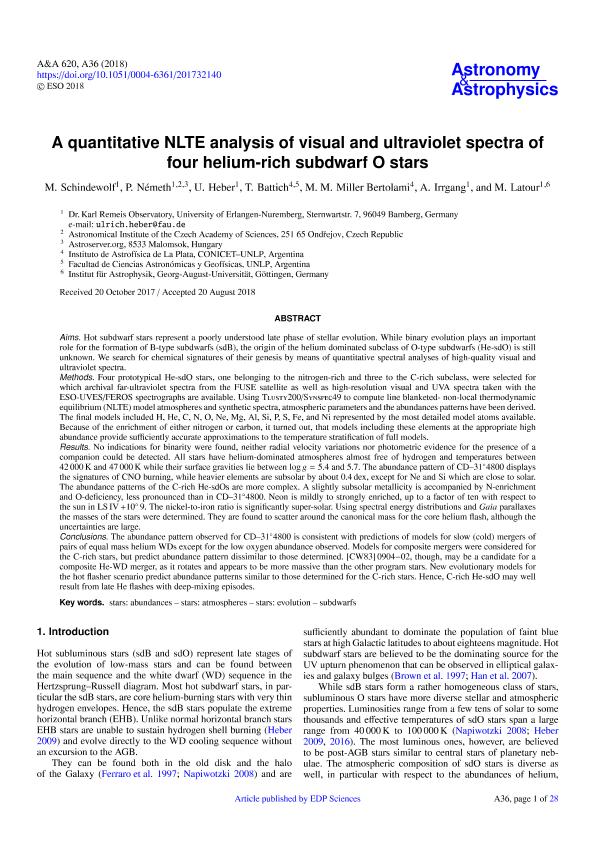Mostrar el registro sencillo del ítem
dc.contributor.author
Schindewolf, M.
dc.contributor.author
Németh, P.
dc.contributor.author
Heber, U.
dc.contributor.author
Battich, Tiara

dc.contributor.author
Miller Bertolami, Marcelo Miguel

dc.contributor.author
Irrgang, A.
dc.contributor.author
Latour, M.
dc.date.available
2019-08-29T19:05:22Z
dc.date.issued
2018-12
dc.identifier.citation
Schindewolf, M.; Németh, P.; Heber, U.; Battich, Tiara; Miller Bertolami, Marcelo Miguel; et al.; A quantitative NLTE analysis of visual and ultraviolet spectra of four helium-rich subdwarf O stars; EDP Sciences; Astronomy and Astrophysics; 620; A36; 12-2018; 1-32
dc.identifier.issn
0004-6361
dc.identifier.uri
http://hdl.handle.net/11336/82514
dc.description.abstract
Aims. Hot subdwarf stars represent a poorly understood late phase of stellar evolution. While binary evolution plays an important role for the formation of B-Type subdwarfs (sdB), the origin of the helium dominated subclass of O-Type subdwarfs (He-sdO) is still unknown. We search for chemical signatures of their genesis by means of quantitative spectral analyses of high-quality visual and ultraviolet spectra. Methods. Four prototypical He-sdO stars, one belonging to the nitrogen-rich and three to the C-rich subclass, were selected for which archival far-ultraviolet spectra from the FUSE satellite as well as high-resolution visual and UVA spectra taken with the ESO-UVES/FEROS spectrographs are available. Using Ta LUSTY200/Sa YNSPEC49 to compute line blanketed-non-local thermodynamic equilibrium (NLTE) model atmospheres and synthetic spectra, atmospheric parameters and the abundances patterns have been derived. The final models included H, He, C, N, O, Ne, Mg, Al, Si, P, S, Fe, and Ni represented by the most detailed model atoms available. Because of the enrichment of either nitrogen or carbon, it turned out, that models including these elements at the appropriate high abundance provide sufficiently accurate approximations to the temperature stratification of full models. Results. No indications for binarity were found, neither radial velocity variations nor photometric evidence for the presence of a companion could be detected. All stars have helium-dominated atmospheres almost free of hydrogen and temperatures between 42 000 K and 47 000 K while their surface gravities lie between log g = 5.4 and 5.7. The abundance pattern of CD-31°4800 displays the signatures of CNO burning, while heavier elements are subsolar by about 0.4 dex, except for Ne and Si which are close to solar. The abundance patterns of the C-rich He-sdOs are more complex. A slightly subsolar metallicity is accompanied by N-enrichment and O-deficiency, less pronounced than in CD-31°4800. Neon is mildly to strongly enriched, up to a factor of ten with respect to the sun in LS IV +10° 9. The nickel-To-iron ratio is significantly super-solar. Using spectral energy distributions and Gaia parallaxes the masses of the stars were determined. They are found to scatter around the canonical mass for the core helium flash, although the uncertainties are large. Conclusions. The abundance pattern observed for CD-31°4800 is consistent with predictions of models for slow (cold) mergers of pairs of equal mass helium WDs except for the low oxygen abundance observed. Models for composite mergers were considered for the C-rich stars, but predict abundance pattern dissimilar to those determined. [CW83] 0904-02, though, may be a candidate for a composite He-WD merger, as it rotates and appears to be more massive than the other program stars. New evolutionary models for the hot flasher scenario predict abundance patterns similar to those determined for the C-rich stars. Hence, C-rich He-sdO may well result from late He flashes with deep-mixing episodes.
dc.format
application/pdf
dc.language.iso
eng
dc.publisher
EDP Sciences

dc.rights
info:eu-repo/semantics/openAccess
dc.rights.uri
https://creativecommons.org/licenses/by-nc-sa/2.5/ar/
dc.subject
Stars: Abundances
dc.subject
Stars: Atmospheres
dc.subject
Stars: Evolution
dc.subject
Subdwarfs
dc.subject.classification
Astronomía

dc.subject.classification
Ciencias Físicas

dc.subject.classification
CIENCIAS NATURALES Y EXACTAS

dc.title
A quantitative NLTE analysis of visual and ultraviolet spectra of four helium-rich subdwarf O stars
dc.type
info:eu-repo/semantics/article
dc.type
info:ar-repo/semantics/artículo
dc.type
info:eu-repo/semantics/publishedVersion
dc.date.updated
2019-08-23T17:45:02Z
dc.journal.volume
620
dc.journal.number
A36
dc.journal.pagination
1-32
dc.journal.pais
Francia

dc.description.fil
Fil: Schindewolf, M.. Universitat Erlangen-Nuremberg; Alemania
dc.description.fil
Fil: Németh, P.. Universitat Erlangen-Nuremberg; Alemania
dc.description.fil
Fil: Heber, U.. Universitat Erlangen-Nuremberg; Alemania
dc.description.fil
Fil: Battich, Tiara. Consejo Nacional de Investigaciones Científicas y Técnicas. Centro Científico Tecnológico Conicet - La Plata. Instituto de Astrofísica La Plata. Universidad Nacional de La Plata. Facultad de Ciencias Astronómicas y Geofísicas. Instituto de Astrofísica La Plata; Argentina
dc.description.fil
Fil: Miller Bertolami, Marcelo Miguel. Consejo Nacional de Investigaciones Científicas y Técnicas. Centro Científico Tecnológico Conicet - La Plata. Instituto de Astrofísica La Plata. Universidad Nacional de La Plata. Facultad de Ciencias Astronómicas y Geofísicas. Instituto de Astrofísica La Plata; Argentina
dc.description.fil
Fil: Irrgang, A.. Universitat Erlangen-Nuremberg; Alemania
dc.description.fil
Fil: Latour, M.. Universitat Erlangen-Nuremberg; Alemania
dc.journal.title
Astronomy and Astrophysics

dc.relation.alternativeid
info:eu-repo/semantics/altIdentifier/doi/http://dx.doi.org/10.1051/0004-6361/201732140
dc.relation.alternativeid
info:eu-repo/semantics/altIdentifier/url/https://www.aanda.org/articles/aa/abs/2018/12/aa32140-17/aa32140-17.html
Archivos asociados
